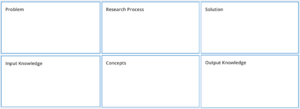The Design Science Research Grid: Difference between revisions
No edit summary |
No edit summary |
||
| Line 14: | Line 14: | ||
== Output Knowledge == | == Output Knowledge == | ||
What kind of knowledge does the DSR project produce? Naturally, DSR projects generate design knowledge, which is referred to as omega knowledge <ref>Gregor, S., and Hevner, A. 2013. “Positioning and Presenting Design Science Research for Maximum Impact,” MIS Quarterly (37), pp. 337–356. (https://doi.org/10.25300/MISQ/2013/37.2.01). | What kind of knowledge does the DSR project produce? Naturally, DSR projects generate design knowledge, which is referred to as omega knowledge <ref>Gregor, S., and Hevner, A. 2013. “Positioning and Presenting Design Science Research for Maximum Impact,” MIS Quarterly (37), pp. 337–356. (https://doi.org/10.25300/MISQ/2013/37.2.01). | ||
</ | </ref>. However, unlike the solution description, the design knowledge produced by the project puts the problem and solution spaces in relation to one another. If a DSR project's goal is to create design entities rather than design theory, the descriptions of such entities do not represent design knowledge because only the outcomes of the design entity's evaluation in context do. When the project is explained, these results are subsequently documented as output knowledge. | ||
== References == | == References == | ||
Latest revision as of 17:54, 8 November 2022
The DSR Grid [1] empowers researchers to successfully plan, coordinate and communicate their DSR projects. The DSR grid intends to put a complete DSR project on one page, highlighting its fundamental components in arrange to reflect and communicate its scope. Such representation of a DSR project helps to arrange and communicate a DSR project as well as to get input from diverse partners in an early stage and to question and update the scope as the project advances. The DSR Grid consists of the six main dimensions of a DSR venture.
Problem Description
What is the problem for which a DSR project aims to deliver a possible solution? Problems ought to be defined by means of problem articulations and characterized by positioning the problem in a problem space. Previous research has identified the context, described by the domain, the stakeholder, time and place, and goodness criteria [2] .
Input Knowledge
What previous knowledge will be used in the DSR design? Design knowledge can be either descriptive, explicatory, prophetic (omega knowledge) or prescriptive (delta knowledge). Three different types of input — kernel theories, design theories, and design entities — can be differentiated for high-level communication about DSR projects.
Research Process
What are the essential activities planned (or conducted) to make the intended contribution? When the intended contribution is design entities, the process includes building and evaluating activities. These activities specifically include anchoring the design through the execution of tasks like literature reviews and meta-analyses. It is recommended that the construction and assessment activities be planned and documented together in order to facilitate concurrent design and evaluation. A high-level list of research activities used to scope the DSR project in the process dimension can be enhanced by logs of the research process that are kept using DSR tools. These actions for theorizing on the design may also be included in the process described. Activities for theorizing can draw from a variety of research methodologies and strategies of inquiry, including qualitative and quantitative empirical research, whereas activities for processing the design can draw from DSR process models like the Peffers et al model.
Key concepts
What are the core concepts that were utilized in the DSR project's research? The concepts used to describe the process and input and output knowledge, as well as the words used to characterize the study, such as the problem and solution space that the DSR project focuses on, must be described precisely. To ensure a rigorous execution of the evaluation activities, it is especially crucial to have a precise definition of the key concepts.
Solution Description
What is the solution to the problem that a DSR project is investigating?
The solution description identifies the representation of the solution as a construct, a model, a method, an instantiation, or a design theory and expresses concisely the fundamental mechanisms of the solution and how the solution is situated in the solution space.
Output Knowledge
What kind of knowledge does the DSR project produce? Naturally, DSR projects generate design knowledge, which is referred to as omega knowledge [3]. However, unlike the solution description, the design knowledge produced by the project puts the problem and solution spaces in relation to one another. If a DSR project's goal is to create design entities rather than design theory, the descriptions of such entities do not represent design knowledge because only the outcomes of the design entity's evaluation in context do. When the project is explained, these results are subsequently documented as output knowledge.
References
- ↑ vom Brocke, J., and Maedche, A. 2019. “The DSR Grid: Six Core Dimensions for Effectively Planning and Communicating Design Science Research Projects,” Electronic Markets (29). (https://doi.org/10.1007/s12525-019-00358-7).
- ↑ vom Brocke, J., Winter, R., Hevner, A., and Maedche, A. 2020. “Accumulation and Evolution of Design Knowledge in Design Science Research - A Journey Through Time and Space,” Journal of the Association for Information Systems (21), pp. 520–544. (https://doi.org/10.17705/1jais.00611).
- ↑ Gregor, S., and Hevner, A. 2013. “Positioning and Presenting Design Science Research for Maximum Impact,” MIS Quarterly (37), pp. 337–356. (https://doi.org/10.25300/MISQ/2013/37.2.01).
